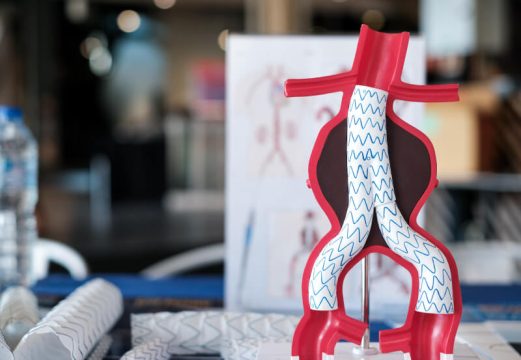Intramural hematoma (IMH) is considered a subtype of acute aortic syndrome (AAS), and some authors describe it as a developmental stage that might cause high morbimortality events such as dissection, aneurysm, or aortic rupture.

One of the CT findings associated with IMH is focal contrast enhancement (FCE) within the intramural hematoma, with a reported incidence of up to 30%. This FCE can be sub-classified according to compromise into a focal intimal disruption (FID) or an intramural blood pool (IBP), also known as pseudoaneurysm of an intercostal artery. Neither FID nor IBP tend to be complications from high risk atherosclerosis plaque, such as penetrating aortic ulcers (PAU).
Prior studies suggest the presence of FID in the acute phase is associated with higher risk of aortic rupture, which calls for data to clarify the prognostic implications of FCE in patients with type B IMH. Also, they have compared the nature course of FCE subtypes with aortic events at midterm.
Presented by Jiang et al., this was a retrospective observational study carried out at Fudan University (China), including patients with AAS and FCE diagnosis with type B IMH. It excluded FCE patients with >20 mm maximal dimension that would have received emergency surgery.
CT followup was at 1, 6 and 12 months after discharge. Patients with aortic diameter >55 mm, signs of rupture, >5 mm annual growth and/or uncontrolled pain were considered for percutaneous intervention. End points included all-cause mortality, aortic related mortality, aortic complications requiring surgery or endovascular intervention, and adverse aortic events (AAE).
Between January 2009 and December 2019, 3259 cases of AAS were diagnosed, 574 were diagnosed with type B IMH, with or without FCE. 36.1% presented FCE, with 63.8% FID and 36.2% IBP. IMH patients with FCE had more high blood pressure or pleural effusion, and the FID group presented more diabetes and cardiomyopathies.
Patients with FCE had longer hospital stay (9.0±2.1 vs 8.3±1.1 days), and 59.7% saw freedom from intervention at 5 years (CI 95%: 52.4%-66.3%), vs 73.7% for IMH without FCE (CI 95%: 68.7%-78.1%). 25% of FID and 18.7% of IBP patients progressed and required intervention during the acute phase. At sub-acute/chronic phase, 34.3% of FID and 13.3% of IBP patients developed AAE.
FIDs presenting complications tended to localize mainly at the proximal descending aorta (p < 0.001), a topographic difference that was not observed in IBP cases.
0.5% of IMH patients without FCE died in the hospital because of aortic rupture. There were no significant differences in general mortality or aortic related mortality in IMH cases with and without FCE.
Multivariable analysis showed the presence of pleural effusion (HR: 1.79; CI95%: 1.25-2.55; P=0.001) and FCE (HR: 1.51; 95% CI: 1.12-2.02; p=0.006) were independent risk factors of acute events.
Conclusions
In this observational study of patients with IMH in the context of AAS, CT assessed pleural effusion and FCE were linked to worse prognosis, especially the FID subtype at the proximal descending aorta. Waiting should be reconsidered, in these cases, since a more aggressive intervention might prevent events.

Dr. Omar Tupayachi.
Member of the Editorial Board of SOLACI.org.
Original Title: Prognostic Implications of Initial Focal Contrast Enhancement in Acute Type B Intramural Hematoma.
Reference: Jiang, X, Pan, T, Liu, Y. et al. Prognostic Implications of Initial Focal Contrast Enhancement in Acute Type B Intramural Hematoma. J Am Coll Cardiol. 2024 Jan, 83 (4) 503–513. https://doi.org/10.1016/j.jacc.2023.10.046.
Subscribe to our weekly newsletter
Get the latest scientific articles on interventional cardiology





